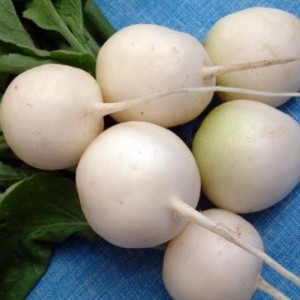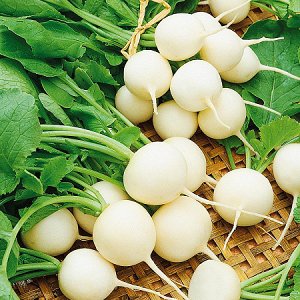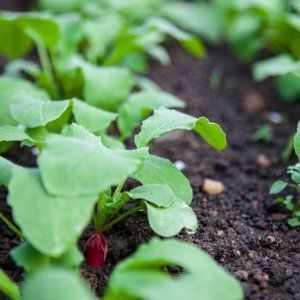What is special about white radish: description and characteristics of varieties
Most often, on the shelves of shops and markets, there is a familiar to everyone radish with a red and pink color. However, varieties with white fruits are gaining more and more fans with their mild taste.
In the article you will find information on how exactly white radish differs from red, how to grow it correctly and how to use it.
The content of the article
Description of culture
Radish belongs to the cruciferous family and is listed as the closest relative of another sharp root vegetable - radish... In Southeast Asia and the Mediterranean, the vegetable has been cultivated for several millennia.
For the first time, radishes were brought to Russia only in the 18th century from France, so the curiosity was called "French radish".
White radish belongs to the same plant species as the usual red one, namely, to the Sowing radish.
White radish varieties

The white-fruited radish cannot yet boast the same variety of varieties as the red one.
However, even among the white-colored root crops, there are samples that are different from each other in shape, ripening time and taste nuances.
White Fang
The miniature fruit of an elongated conical shape reaches only 4 cm in length. The taste of such a radish is spicy, with a characteristic bitterness. Cultivated only outdoors.
Glowworm
Mid-season variety. Root crops are small, up to 10 cm long, shaped like an icicle. There is a sweet note in the taste. Suitable for cultivation in greenhouses and open field.
Alba
Belarusian mid-season, fruitful variety. The fruit has a conical shape, covered with a snow-white and thin skin. Differs in good keeping quality and resistance to shooting.
Ice icicle
A late-ripening variety, named for the characteristic shape of the root, reaching 15 cm in length. The crop is harvested 35-40 days after landing... It has a juicy and crunchy pulp. Suitable for growing both outdoors and in a greenhouse.
Virovsky white
Differs in the classic round shape of the root crop about 4 cm in diameter. The pulp is practically devoid of pungency; it will not flab for a long time during storage.
Designed for open ground, the crop is harvested 26-33 days after germination (mid-season variety).
Daikon
It is often called Japanese or Chinese radish, as it is widely used in Asian cuisine, especially when pickled. Strictly speaking, daikon has a distant relation to radish, but it belongs to the same type of plant - Sowing Radish.
Depending on the specific variety, the daikon can take on a conical, cylindrical, more square or rounded shape. The vegetable differs from ordinary white radish in its large size - some representatives grow up to 40 cm in length and weigh about 5 kg. In addition, daikon leaves are excised, and the pulp does not taste bitter due to the small amount of mustard oil.
Chemical composition, trace elements, vitamins and beneficial properties
White radish is rich in fiber and contains only 15 kcal per 100 g of product, which makes the vegetable an indispensable aid in losing weight. The same portion of the plant supplies the body:
- 32% of the daily value of ascorbic acid (vitamin C);
- 11% potassium;
- 10% copper.
Other beneficial substances include:
- vitamins E, PP, group B;
- macronutrients (sodium, magnesium, calcium);
- iron salts;
- nitrogenous compounds and ash substances;
- natural sugars.
Thanks to this composition, radishes:
- improves immunity and helps with vitamin deficiency;
- improves metabolic processes, intestinal peristalsis and normalizes cholesterol;
- has a slight choleretic and diuretic effect, is used to relieve edema;
- useful for anemia.
The vegetable is contraindicated in diseases of the digestive tract (ulcer, gastritis, colitis, pancreatitis) and problems with the thyroid gland. Do not abuse the product for people who have had a heart attack, children under 3 years old, pregnant and lactating women.
Reference. Eaten not only root vegetables, but also young greens... The plant is used fresh, pickled or after heat treatment as a side dish for meat or a component of hot dishes.
For which regions it is best suited and what is the exacting climate
Due to its frost resistance, white radish shows high yields in areas with close to extreme agro-climatic conditions: in the North and in Siberia.
In the middle lane and the Central Black Earth region, it is possible to collect several vegetable crops per season, but prolonged heat has a negative effect on the indicators. The easiest way to regulate the level of humidity, illumination and temperature is in greenhouses and greenhouses.
The main advantages and disadvantages of white radish
White radish compares favorably with its colored counterparts in that:
- Retains taste and firm texture for longer.
- Has a more delicate flavor than red varieties.
- Does not contain dyes from the group of glycosides - anthocyanins, which color the peel in a bright color and can cause unwanted reactions in humans, therefore it is more suitable for dietary nutrition.
- It has a shortened vegetative period, so several crops can be grown per season.
White varieties have only one drawback, a very conditional one: the delicate taste can disappoint lovers of spicy radish.
Features of planting and growing in the greenhouse and in the open field
Radish belongs to cold-resistant and unpretentious crops, easily tolerating spring return frosts. This vegetable is one of the first to ripen, appearing on the table of the summer resident in May-June.
Preparing for landing
It is advisable to prepare the bed in the fall: dig up the soil, remove weeds and fertilize the soil. As a top dressing on winter choose mineral fertilizers - superphosphate and potassium chloride - or rotted compost. By spring, nutrients are converted into easily digestible forms.
Immediately before sowing, nitrogen-containing fertilizers are applied to the soil: urea, manure, etc.
Reference. In order for the seeds to sprout faster and the plant to develop faster, the prepared beds can be watered with a warm solution of sodium humate.
Seed material is disinfected by soaking for half an hour in a pink solution of potassium permanganate, then dried on gauze or other soft matter. Some gardeners carry out preliminary hardening of the seeds: they are heated for 15 minutes in hot water, immediately cooled in cold water, and then put in the refrigerator for a day.
Ground requirements
White radish is not picky about the soil, although it prefers loose, well-ventilated sandy loam or loamy soils. Heavy clay soils are balanced with sand or peat. In addition, the plant does not tolerate soil acidification, so in the fall the land is lime.
With a lack of nutrients, especially potassium, radish practically does not form a root crop, therefore, it needs careful preparation of the soil before planting.
The ideal precursors for radishes are cucumbers, tomatoes, onions, potatoes or garlic.
Reference. Particular attention is paid to the choice of a site for planting. Long-term shading of the beds is not allowed, since radishes are sensitive to lack of light.
Timing, scheme and landing rules

Radishes are planted in open ground when the snow has melted and the soil has warmed up to + 3 ° C. Seeds are laid in grooves 2 cm deep, observing a step of 4-7 cm.
Top covered with dry soil mixture - garden soil, humus and sand in a ratio of 2: 2: 1. The top layer of earth can be lightly tamped and must be plentifully, but carefully watered with warm water.
In warm weather, seedlings appear on the fifth day after planting. Root crop growth begins in 1.5-2 weeks.
Under the film, radishes are sown in early April, while the sun is not too active. On warm, windless days, the shelter is removed, giving the plant the opportunity to "breathe".
Reference. The soil warms up faster under the black film than under the transparent one.
To harvest the first crop in early May, radishes are planted in March using the seedling method. Sprouts can be dived into open ground or a greenhouse when the seedlings already have several leaves - usually it takes 10-15 days after planting.
Growing features
For the full development of tops and root crops, a temperature of +10 to + 18 ° C and good illumination are required. At the same time, radish relatively prefers a short daylight hours, therefore it is planted in the spring or in the second half of summer. With prolonged exposure to the sun, the plant forms flower stalks.
If the green shoots are stretched out, this indicates a lack of lighting. You can correct the situation by hilling the furrow and ensuring maximum access of light to the garden bed. This requires regularly weeding not only at the planting site, but also in the aisle.
Watering mode
Radish loves even, frequent and abundant watering. Moisten the soil at least 7-10 cm deep, and if the root crop is long - 20-30 cm.Watering frequency depends on weather conditions: at moderate summer temperatures, once every 2-3 days is enough, and in heat and drought you will need to water the beds every day, morning and evening.
Loosening the soil and weeding
Weeding is carried out twice:
- for the first time - a week after germination, to a depth of 5 cm;
- in the second - a week later, by 7-10 cm.
They loosen the soil carefully so as not to damage the root system of the plant. Weeds are removed before they have settled in the ground, so as not to accidentally pull out the emerging roots. Weeding provides an uninterrupted supply of oxygen, solar heat and light to the radishes.
Top dressing
Fertilizing before sowing is enough to stop root dressing during the growing season. Excess nitrogenous fertilizers provoke an excessive build-up of green mass to the detriment of root crops.
If the soil is depleted and contains little humus, you can feed it with "green tea" - a fermented infusion of dandelion leaves and nettle.
Disease and pest control
White radish is susceptible to fungal diseases such as:
- Keela - growths are formed on root crops, the pulp begins to brown and rot.
- Powdery mildew - appears as a white, gradually darkening plaque on the leaves. The tops dries up, and the plant stops developing.
- Gray rot - Root crops are covered with brown spots and a velvety gray bloom.
Diseases spread mainly through fresh manure or contaminated soil, therefore, before sowing, it is useful to add wood ash (100 g per sq. M) to the soil and avoid top dressing with unripe organic matter. Favorable conditions for the activation of mushroom spores are cold summers with prolonged rains and stagnant water in the beds. For the purpose of prevention, follow the rules of crop rotation, loosen row spacings and weed in time.
At the first signs of a disease, plants are treated with milk of lime, a solution of copper sulfate and industrial fungicides.
Among insect pests, the most dangerous for white radish wireworm (the larva of the click beetle), eating deep passages in the juicy pulp of the root vegetable, and cruciferous flea - a lover to feast on young green shoots. Pest control includes the use of insecticides or folk remedies. For example, spraying with soapy water with the addition of ash or tobacco.
Harvesting and storage
A trial harvest is possible on the 20th day. If the roots are ripe, do not delay their harvesting, as the plant can enter the phase of flowering and seed formation.
At the end julywhen the day begins to wane, you can plant the radish a second time.
The collected radish is cleaned of adhering soil, dried and sent to storage in a cool place: refrigerator or cellar.
Reference. Some varieties, such as the Autumn Giant, retain their dense texture and taste for up to five months.
What can be the difficulties in growing
If the vegetable is not provided with optimal conditions cultivation, the radish goes into an extreme survival mode - all the plant's forces are directed to the formation of a flower arrow instead of root crops.
The culture does not tolerate the thickening of the planting... The tops begin to stretch upward, and the crowding roots grow curved and hollow inside.
With insufficient watering, the roots become tough and hollow, and bitterness accumulates in them. On the contrary, waterlogged soil leads to cracking of the pulp.
Tips from experienced gardeners

The cultivation of such a radish is a novelty for many, so it is worth listening to experienced vegetable growers:
- In order not to resort to the help of dangerous chemicals, it is recommended to scare away insects with a pungent smell of tobacco dust or garlic infusion.
- Planting in a garden bed where other cruciferous plants were previously grown: cabbage, radish and turnip reduces the immunity of radish.
- When watering young plants, be especially careful not to erode the soil and expose the hypocotal knee. Otherwise, the roots are not formed or take on an ugly shape.
Reviews of varieties of white radish
Many summer residents, having once tasted white radish, remain faithful to it for many years. Here are some examples of typical reviews:
Elena, Samara: «My stomach does not react well to the bitter skin of red radish, so when cooking okroshka I always had to peel it off. I tried the Alba variety. I planted it in early spring, until the snow melted, in the greenhouse, the seeds sprout quickly, and after a month they were ripe. I was surprised how thin the skin of this radish is! The pulp itself is juicy, tender and tasty. Now I will not return to the red-skinned varieties. "
Lyudmila, Moscow: “The variety of daikon Elephant Fang pleased me. It is unpretentious in care, we plant it even in an empty place after harvesting other vegetables, it grows quickly, and one tuber is enough for a whole salad. Store in the basement for 2-3 months. For me it tastes better than a radish. "
Alexander, Belgorod: "My favorite radish is Mokhovsky. The fruits are perfectly stored in a plastic bag in the lower compartment of the refrigerator. Month and a half do not flabby and remain juicy. I sow at the earliest possible date or at August, since radish is not afraid of frost. If I shoot a flower arrow, I don’t throw out the seeds, they remain viable for 4-5 years ”.
Conclusion
White radish has undoubted advantages over red: due to the absence of coloring substances, it is more suitable for dietary nutrition, has a mild taste and retains freshness for longer. In addition, the agricultural technology of a vegetable is simple and will not cause problems even for a novice gardener.
Early ripe varieties will come in handy during the spring beriberi and diversify the usual diet.